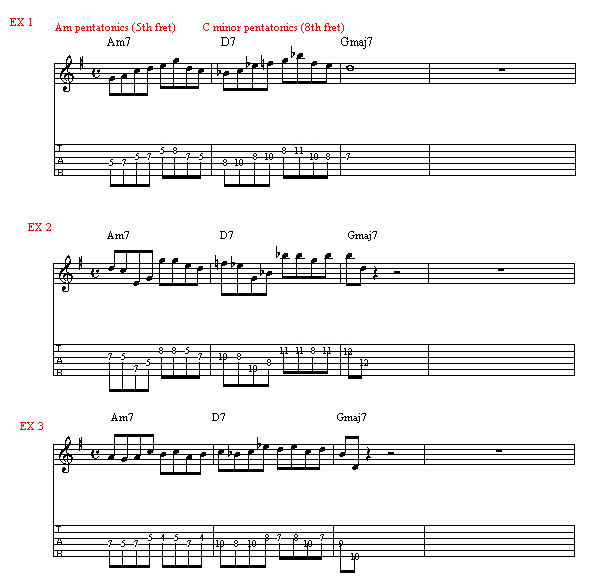Part One: Melody
Focuses on single note soloing. Learn how to effortlessly solo through complex chord changes.
Free Jazz Guitar Lessons with Chris Standring
Here's a simple recipe for generating hip altered notes over the V in a IIm-V-I progression.
In a IIm-V-I progression, the V is typically the critical chord to
color with altered sounds. A V provides tension that you release by
playing the I chord; adding melodic tension to the V makes this release
even more dramatic. Here's a simple recipe for generating hip altered
notes over the V in a IIm-V-I progression. Let's try it in G, over Am7,
D7 and Gmaj7.
Bar 1: Find the fifth-position A minor pentatonic scale we all
know and love, and use it to craft a line over Am7 (the IIm) containing
no more than eight eighth-notes.
Bar 2: Move up a minor third to the eighth-position C minor pentatonic position and repeat the line over D7, the V.
Bar 3: Resolve the phrase by a half-step to a Gmaj7 chord tone.
(Visualizing Gmaj7 voicings at the 7th fret will help you see the one-fret
resolutions.)
Ex. 1 illustrates the "pentatonic-up-three-frets" IIm-V
process. First record the changes, and then play the line to hear the
tension and release. Moving bar 1's phrase up a minor third in bar 2
automatically gives you three of D7's altered notes -- the #5 (A# -
notated here as Bb) b9, (Eb), and #9 (notated here as F)
In Ex. 2, notice how the last note of bar 2's transposed line
changes to accommodate the half-step resolution in bar 3. Once you hear
this V-I shift, you'll find it easily on the fretboard. Again, for maximum
payoff, play this over the chords.
When you've mastered the basics, you can loosen things up. For example, you don't always have to resolve by step (although this sounds the smoothest), nor are you limited to a minor pentatonic scale. Ex. 3 moves an A Dorian phrase up the neck to C Dorian and then resolves to the I with a major-third interval.
Use this finger-friendly technique to create uptown sounds with minimum effort .

Free online jazz guitar lessons for beginners, intermediates and advanced.
Online jazz guitar instruction from recording artist Chris Standring
Join The Inside Track membership and get access to all Chris Standring's guitar instructional programs, all in one place.
It has been many years since the first edition of Play What You Hear (originally released in 2000). Now volume two is here with new ideas and concepts, complete with audio, video, traditional notation and TAB throughout. High resolution pdf available for printing the entire program. For intermediate and advanced players.
Focuses on single note soloing. Learn how to effortlessly solo through complex chord changes.
Focuses on chord melody. Learn new harmonic devices and understand chords in a whole new way.
Study Chris Standring's six recorded solos, transcribed with audio and high def video.
Copyright © PlayJazzGuitar.com - All Rights Reserved.